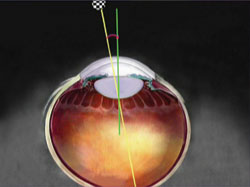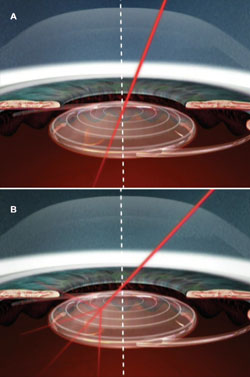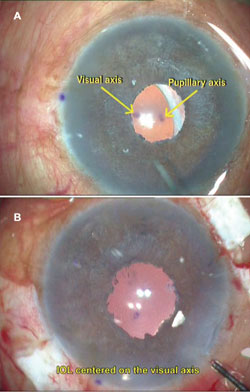Angle kappa may play important role in success of multifocal IOLs
 Amar Agarwal |
Angles of the eye have, of late, received a renewed interest secondary to the significant role they play in refractive surgery.
Angle kappa is the angle between the visual axis and the pupillary axis (Figure 1). It is clinically important to the refractive surgeon because patients, especially hyperopes, have a large angle kappa and the center of the pupil is no longer the point through which a fovea-centric ray of light passes. Thus, any treatment that is performed centered on the pupil results in a decentered ablation. This effect is more pronounced with corrections for astigmatism and higher-order aberrations if angle kappa is not compensated for.
 Figure 1. Angle kappa is the angle between the visual axis and the pupillary axis. Images: Agarwal A |
Angle kappa and multifocal IOLs
But what role does angle kappa play for the cataract surgeon? We know that multifocal IOLs work by creating multiple focal points that focus for distance and near (Figure 2). We also know that patients with monofocal IOLs have traditionally been more satisfied with their visual outcome with regard to postop blurry vision, halos, glare and decreased contrast sensitivity. Multifocal IOLs have been associated with these symptoms despite uneventful surgery with the IOL well-centered in the bag. Many factors have been proposed for these phenomena, the most important being a decrease in the intensity of light falling on the retina due to splitting up of incident light into multiple focal points and due to superimposition of the defocused image onto the focused image. But irrespective of these factors being common to all patients, not all patients are equally affected by the symptoms. One of the factors proposed to account for this difference in symptoms is varying degrees of neuroadaptation. Other factors include IOL decentration, retained lens fragments, posterior capsular opacification, poor ocular surface and postoperative residual refractive error. The newer-model multifocal IOLs have fewer symptoms associated with them.
 Figure 2. A: In eyes with small angle kappa, a fovea centric ray may pass through the central ring of the multifocal IOL. B: In eyes with large angle kappa, a fovea centric ray may hit on the edge of the ring, causing edge glare effects and deterioration in quality of vision. |
A lesser-studied entity is the angle kappa. Angle kappa is the distance between the center of the pupil and the light reflex. The vertex normal or the light reflex is near the visual axis at the corneal plane. Angle kappa can be measured with a synoptophore or using the Orbscan II (Bausch + Lomb). The average angle kappa is about ±5°. Effect of angle kappa on multifocal IOLs has been evaluated previously by attempting iridoplasty to make the pupil concentric to the center of the IOL. This could theoretically increase the effect of higher-order aberrations because of an increase in the pupil size.
Multifocal glued IOL
Just as the corneal intercept of the visual axis is used for centration of ablation in LASIK, we attempted to use the angle kappa measurement as an intraoperative guide to center a multifocal IOL. We marked the visual axis using the coaxially sighted light reflex. We then marked the pupillary center and centered a multifocal IOL using the glued IOL technique (Figure 3). We marked the visual axis and the pupillary center on the cornea.
 Figure 3. A glued multifocal IOL being done in an aphakic eye in an attempt to center the rings on the visual axis. A: The pupillary axis and the visual axis marked preoperatively. B: The multifocal IOL rings centered on the pupillary axis after a glued IOL procedure, which allows adjustment of the rings by adjusting the flaps, sclerotomies and the degree of tuck of individual haptics. |
Despite the inability to ensure perfect accuracy, we observed promising results with this technique.
There are certain situations where, despite best attempts, a centered multifocal IOL in the bag may not be possible in a patient who wants a multifocal. In such a patient, it is possible to perform a glued IOL and to adjust the centration by adjusting the location of the scleral flaps, sclerotomies and the degree of tuck of individual haptics. In other situations such as microspherophakia, our preferred practice is to do a lensectomy and implant a glued IOL, which, if it is multifocal, needs to be centered on its rings. It would also be ideal to combine this with ray optics and to be able to center the IOL ideally so that the light ray passes from fixation through the center of the rings to the fovea.
In the event of a posterior capsular rent, it is not advisable to place a multifocal IOL in the sulcus for fear of postoperative decentration. If in-the-bag multifocal IOL implantation is not possible, a glued multifocal IOL may be preferable, as the IOL is stable with no postoperative decentration occurring from its intraoperative positioning. In all these complicated situations as well as, more importantly, in the routine multifocal IOL patients, it is important to take the angle kappa into consideration for IOL centration. Future advances might also include IOL customization to match the angle kappa of the patients, although postop capsular contraction and IOL rotation would be challenges to overcome.
Visual satisfaction
We also studied angle kappa in relation to visual satisfaction in multifocal patients and found photic phenomena to have an association with angle kappa. Multifocal IOLs work on either a refractive or a diffractive principle and have either multifocal zones or steps. In an eye with a small angle kappa, the ray of light would be able to pass through the IOL center without disturbance, but in an eye with a large angle kappa, a fovea centric ray might hit on the edge of the ring, thus giving rise to edge glare effects (Figure 4). This might be severe enough to result in having to explant such an IOL and replace it with a different IOL. A monofocal IOL in an eye with a large angle kappa would not cause as much visual disturbance as a decentered multifocal IOL because of the lack of steps or rings on its surface.
 Figure 4. A: A multifocal IOL that is centered on the pupillary axis but not on the visual axis in an eye with large angle kappa. B: Possible future customization of multifocal IOLs to allow centration of rings on the visual axis. |
Conclusion
To conclude, we propose that it is important to focus more research on the association between angle kappa and multifocal IOLs. It may be important to consider angle kappa for all prospective multifocal IOL patients and to avoid multifocal implantation in patients with large angle kappa until advances make accurate centering of IOLs possible.

- Amar Agarwal, MS, FRCS, FRCOphth, is director of Dr. Agarwal’s Eye Hospital and Eye Research Centre. Prof. Agarwal is the author of several books published by SLACK Incorporated, publisher of Ocular Surgery News, including Phaco Nightmares: Conquering Cataract Catastrophes, Bimanual Phaco: Mastering the Phakonit/MICS Technique, Dry Eye: A Practical Guide to Ocular Surface Disorders and Stem Cell Surgery and Presbyopia: A Surgical Textbook. He can be reached at 19 Cathedral Road, Chennai 600 086, India; fax: 91-44-28115871; e-mail: dragarwal@vsnl.com; Web site: www.dragarwal.com.
- Dr. Agarwal is a consultant to Bausch + Lomb.
